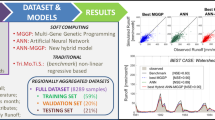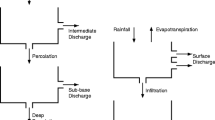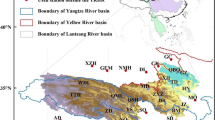Abstract
Genetic programming (GP) is recognized as a robust machine learning method for rainfall-runoff modelling. However, it may produce lagged forecasts if autocorrelation feature of runoff series is not taken carefully into account. To enhance timing accuracy of GP-based rainfall-runoff models, the paper proposes a new rainfall-runoff model that integrates season algorithm (SA) with multigene-GP (MGGP). The proposed SA-MGGP model was trained and validated for single- and two- and three-day ahead streamflow forecasts at Haldizen Catchment, Trabzon, Turkey. Timing and prediction accuracy of the proposed model were assessed in terms of different efficiency criteria. In addition, the efficiency results were compared to those of monolithic GP, MGGP, and SA-GP forecasting models developed in the present study as the benchmarks. The outcomes indicated that SA augments timing accuracy of GP-based models in the range 250% to 500%. It is also found that MGGP may identify underlying structure of the rainfall-runoff process slightly better than monolithic GP at the study catchment.







Similar content being viewed by others
References
Abrahart RJ, Heppenstall AJ, See LM (2007) Timing error correction procedure applied to neural network rainfall—runoff modelling. Hydrol Sci J 52:414–431
Akbari-Alashti H, Bozorg Haddad O, Mariño MA (2015) Application of fixed length gene genetic programming (FLGGP) in hydropower reservoir operation. Water Resour Manag 29:3357–3370
Altunkaynak A, Nigussie TA (2015) Performance Comparison of SAS-Multilayer Perceptron and Wavelet-Multilayer Perceptron Models in Terms of Daily Streamflow Prediction. J Hydrol Eng 21:4015051
Altunkaynak A, Nigussie TA (2017) Monthly Water Consumption Prediction Using Season Algorithm and Wavelet Transform–Based Models. J Water Resour Plan Manag 143(6):04017011
Altunkaynak A, Ozger M (2016) Comparison of discrete and continuous wavelet-multilayer perceptron methods for daily precipitation prediction. J Hydrol Eng 21:1–11
Aytek A, Alp M (2008) An application of artificial intelligence for rainfall-runoff modeling. J Earth Syst Sci 117:145–155
Babovic V, Keijzer M (2000) Genetic programming as a model induction engine. J Hydroinf 2:35–60
Bourdin DR, Fleming SW, Stull RB (2012) Streamflow modelling: a primer on applications, approaches and challenges. Atmosphere-Ocean 50:507–536
Danandeh Mehr A, Demirel MC (2016) on the calibration of multigene genetic programming model for low flow prediction in Moselle River. Uludağ Univ J Fac Eng 21(2):365–376
Danandeh Mehr A, Kahya E (2017) A Pareto-optimal moving average multigene genetic programming model for daily streamflow prediction. J Hydrol 549:603–615
Danandeh Mehr A, Nourani V (2017) A Pareto-optimal moving average-multigene genetic programming model for rainfall-runoff modelling. Environ Model Softw 92:239–251
de Vos NJ, Rientjes THM (2005) Constraints of Artificial Neural Networks For Rainfall-Runoff Modelling: Trade-offs in hydrological state representation and model evaluation. Hydrol Earth Syst Sci Discuss 2:365–415
Fallah-Mehdipour E, Bozorg Haddad O, Mariño MA (2012) Real-time operation of reservoir system by genetic programming. Water Resour Manag 26:4091–4103
Guo J, Zhou J, Qin H, Zou Q, Li Q (2011) Monthly streamflow forecasting based on improved support vector machine model. Exp Syst Appl 38(10):13073–13081
Hinchliffe M, Hiden H, McKay B, Willis M, Tham M, Barton G (1996) Modelling chemical process systems using a multi-gene. Late Breaking Papers at the Genetic Programming, p 56–65
Hrnjica B (2009) GPdotNET V4.0- artificial intelligence tool [Computer program], http://github.com/bhrnjica/gpdotnet. Accessed 01 Nov 2016
Hu T, Wu F, Zhang X (2007) Rainfall–runoff modeling using principal component analysis and neural network. Nord Hydrol 38:235–248
Kalteh AM (2015) Improving forecasting accuracy of streamflow time series using least squares support vector machine coupled with data pre-processing techniques. Water Resour Manag 30(2):747–766
Kisi O, Shiri J, Tombul M (2013) Modeling rainfall-runoff process using soft computing techniques. Comput Geosci 51:108–117
Kitanidis PK, Bras RL (1980) Real-time forecasting with a conceptual hydrologic model: 2. Applications and results. Water Resour Res 16:1034–1044
Kokkonen TS, Jakeman AJ (2001) A comparison of metric and conceptual approaches in rainfall-runoff modeling and its implications. Water Resour Res 37:2345–2352
Koza JR (1992) Genetic programming II, automatic discovery of reusable subprograms. MIT Press, Cambridge
Nourani V, Komasi M, Mano A (2009) A multivariate ANN-wavelet approach for rainfall-runoff modeling. Water Resour Manag 23:2877–2894
Nourani V, Komasi M, Alami MT (2012) Hybrid Wavelet – Genetic Programming Approach to Optimize ANN Modeling of Rainfall – Runoff Process. J Hydrol Eng 17:724–741
Nourani V, Hosseini Baghanam A, Adamowski J, Gebremichael M (2013) Using self-organizing maps and wavelet transforms for space-time pre-processing of satellite precipitation and runoff data in neural network based rainfall-runoff modeling. J Hydrol 476:228–243
Olyaie E, Zare Abyaneh H, Danandeh Mehr A (2017) A comparative analysis among computational intelligence techniques for dissolved oxygen prediction in Delaware River. Geosci Front 8:517–527
Partal T (2009) River flow forecasting using different artificial neural network algorithms and wavelet transform. Can J Civ Eng 36:26–38
Ramsay JO, Silverman BW (2005) Functional data analysis. John Wiley & Sons, Inc.
Sattar AMA, Gharabaghi B (2015) Gene expression models for prediction of longitudinal dispersion coefficient in streams. J Hydrol 524:587–596
Searson, DP (2009) GPTIPS: Genetic programming & symbolic regression for MATLAB. User Guide, 2010
Searson D (2015) GPTIPS 2: an open-source software platform for symbolic data mining. In: Gandomi AH et al (eds) Chapter 22 in Handbook of Genetic Programming Applications. Springer, New York
Shoaib M, Shamseldin AY, Khan S et al (2016) A wavelet based approach for combining the outputs of different rainfall–runoff models. Stoch Env Res Risk A 32(1):155–168
Uyumaz A, Mehr AD, Kahya E, Erdem H (2014) Rectangular side weirs discharge coefficient estimation in circular channels using linear genetic programming approach. J Hydroinf 16:1318–1330
Wang Y, Guo S, Chen H, Zhou Y (2014) Comparative study of monthly inflow prediction methods for the Three Gorges Reservoir. Stoch Env Res Risk A 28:555–570
Wang WC, Chau KW, Qiu L, Chen YB (2015) Improving forecasting accuracy of medium and long-term runoff using artificial neural network based on EEMD decomposition. Environ Res 139:46–54
Wu CL, Chau KW (2010) Data-driven models for monthly streamflow time series prediction. Eng Appl Artif Intell 23:1350–1367
Wu CL, Chau KW (2011) Rainfall-runoff modeling using artificial neural network coupled with singular spectrum analysis. J Hydrol 399:394–409
Yaseen ZM, El-shafie A, Jaafar O et al (2015) Artificial intelligence based models for stream-flow forecasting: 2000-2015. J Hydrol 530:829–844
Acknowledgements
This research was partly funded by Iran’s National Elites Foundation (BMN).
Author information
Authors and Affiliations
Corresponding author
Rights and permissions
About this article
Cite this article
Danandeh Mehr, A., Nourani, V. Season Algorithm-Multigene Genetic Programming: A New Approach for Rainfall-Runoff Modelling. Water Resour Manage 32, 2665–2679 (2018). https://doi.org/10.1007/s11269-018-1951-3
Received:
Accepted:
Published:
Issue Date:
DOI: https://doi.org/10.1007/s11269-018-1951-3




